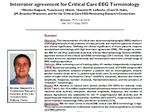ACNS Guideline: The New 2021 Critical Care EEG Terminology - ACNS Annual Course Lawrence J. Hirsch, MD, FACNS Michael W.K. Fong, MD
←
→
Page content transcription
If your browser does not render page correctly, please read the page content below
ACNS Guideline:
The New 2021 Critical Care EEG
Terminology
ACNS Annual Course
Lawrence J. Hirsch, MD, FACNS
Michael W.K. Fong, MDDisclosures, relevant
⚫I bill for continuous EEG monitoring (about 25%
of my clinical billing)
⚫ I co-authored the Atlas of EEG in Critical Care
(Hirsch and Brenner)
⚫ I borrowed some slides from the Critical Care
EEG Monitoring Research Consortium, guideline
co-authors, and Yale colleagues
⚫ Suzette Laroche, Nicholas Abend, Tammy Tsuchida, Sue Herman, Nicolas Gaspard, Brandon
Westover, Suzette Laroche, Andres Rodriguez, Nicolas Gaspard, Emily Gilmore, Gamal Osman,
Jiyeoun Yoo, Carolina Maciel, Nishi Rampal, Michael Fong, Markus LeitingerDisclosures, unrelated ⚫ Consultant ⚫ Accure; Aquestive; Ceribell; Eisai; Medtronic; Neuropace; UCB ⚫ Honoraria for speaking ⚫ Neuropace; Natus ⚫ Royalties ⚫ Wolters Kluwer (UpToDate); Wiley
Second version: an official ACNS guideline
(not just for research anymore)
J Clin Nphysiol 2013
20 authors (13:7, M:F), 19 from N. AmericaACNS Nomenclature inter-rater
agreement, round 3
Gaspard et al, Epilepsia 2014
• Results: IRA statistics (j values) were almost perfect
(90–100%) for seizures, main terms 1 and 2, the +S
modifier, sharpness, absolute amplitude, frequency,
and number of phases.
• Agreement was substantial for the +F and +R
modifiers (66% and 67%), moderate for triphasic
morphology (58%), and fair for evolution (21%).
• Significance: IRA for most terms in the ACNS critical
care EEG terminology is high. These terms are
suitable for multicenter research on the clinical
significance of critical care EEG patterns.American Clinical Neurophysiology
Society’s Standardized Critical Care EEG
Terminology
J Clin Nphys, 2013
CCEMRC Training Module (www.acns.org)
Lawrence Hirsch, Nicolas Gaspard, Brandon Westover, Suzette Laroche
8Development and Feasibility Testing of a Critical Care EEG
Monitoring Database for Standardized Clinical Reporting and
Multicenter Collaborative Research
Lee JW et al for the Crit Care EEG Monitoring Research Consortium.
J Clin Nphys 2016
⚫ Supported by AES Infrastructure Award
⚫ The database and instruction manual were
available as a free download to be used as a
clinical data repository and report generating
tool at: https://www.acns.org/research/critical-
care-eegmonitoring-research-consortium-
ccemrcJAMA Neurol 2017 • 4772 patients undergoing CEEG in 3 centers (Emory, Yale, Brigham and Women’s)
Rodriguez Ruiz A et al, CCEMRC,
JAMA Neurol 2017Risk of acute seizures with LRDA vs LPDs
Gaspard N et al, JAMA Neurology 2013
63%
57%Other studies using the ACNS Terminology
• Higher frequency (especially >1.5 Hz), higher prevalence,
longer duration, and having a “plus” modifier were all
associated with a higher chance of acute seizures (Rodriguez-Ruiz
A et al JAMA Neurol 2017; Pedersen GL et al, Clin Nphysiol 2013)
– Whether stimulus-induced or not did not seem to matter (Rodriguez-Ruiz A et
al JAMA Neurol 2017)
• “Triphasic morphology” was found NOT to be associated with a
higher risk of metabolic encephalopathy or lower risk of seizures
compared to non-triphasic GPDs (Foreman B et al, Clin Nphysiol 2016;
O’Rourke D et al, Neurocrit Care 2016)
• Highly epileptiform bursts were predictive of seizure recurrence
after weaning anesthetics (Thompson SA, Hantus S, J Clin Nphysiol 2016)
• Higher risk of later epilepsy if LPDs were more prevalent,
longer duration or had a “plus” modifier (Pedersen GL et al, Clin
Nphysiol 2013)2021 Terminology has arrived!
J Clin Nphysiol Jan 2021
4,123 authors, 9 continents, 2 planets
30 authors (22:8, M:F), 8 countries, 4 continents
Thanks to all co-authors. Special thanks to Michael
Fong and Markus Leitinger for helping with the
publication, diagrams, figures, EEG samples and slidesGood news ⚫ Most prior terms and definitions remain unchanged ⚫ Mostly added new definitions
Agenda
I. Intro and brief history: L. Hirsch 1:30-1:40 pm (10 min)
II. Background EEG, suppression-burst, reactivity, state changes,
and CAPE: M.W.K. Fong 1:40 - 2:10 (23 min + 7 min Q&A)
III. Rhythmic and Periodic Patterns, including Extreme Delta Brush:
N. Gaspard 2:10 - 2:40 (23 min + 7 min Q&A)
IV. Electrographic and Electroclinical seizures, BIRDs and the Ictal-
Interictal Continuum: L. Hirsch 2:40 – 3:10 (23 min + 7 min Q&A)
V. Cases/reading session: M. Leitinger 3:10 – 3:30 (20 min)You can also read
























































